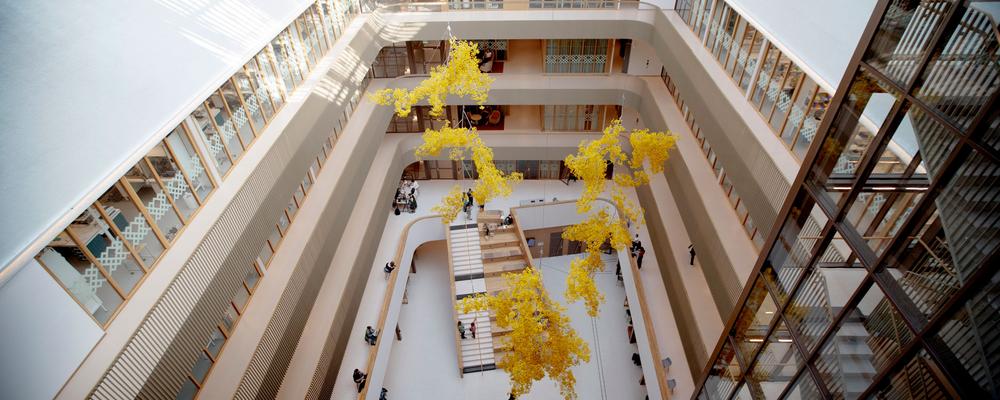– THIS IS A FANTASTIC meeting place!” says project manager Johan Höjesjö.
The ceiling height is striking, the light that comes in is pleasant, and the sound levels are surprisingly low. Those who enter the very heart of Natrium – the atrium – are greeted by a bustling, open environment with an attractive wooden staircase at the centre. Every day, thousands of people cross paths here on their way to laboratories, offices, meeting rooms and study environments.
The enormous building was opened in August 2023. It will strengthen the links between the science departments and, in the long term, between the faculty and Sahlgrenska Academy.
– We’re bringing together a fragmented organisation and creating completely new opportunities for cooperation,” says Johan Höjesjö, a professor at the Department of Biological and Environmental Sciences and internal project manager for the Natrium project.
– When five out of our seven departments are housed in the same premises, we can benefit from each other’s skills, collaborate between courses and identify new research collaborations.
THE DESIGN OF THE building has been carefully thought out, and has been developed in cooperation with both researchers and students. On the top floor are the offices, where the tall windows let in daylight and offer extensive views. The basement houses an aquarium, a laser laboratory, a thermo-constant room and the faculty’s extensive herbarium, which was digitalised as part of the move. Next to the atrium are advanced research and laboratory environments.
One key aim has been to create flexible premises that can easily be adapted as conditions change.
– Research is constantly evolving, he continues. the building therefore has both flexible, general laboratory environments and laboratories with highly specialised functions.
TWO OF THE SEVEN FLOORS are largely dedicated to students. Alongside study spaces, there are also several innovative learning environments. For example, there are active learning classrooms designed for discussions in small groups. There is also a multi-purpose room with large LCD screens, where microphones in the ceiling allow speakers to be heard clearly by everyone, no matter how they move around the room.
Erica Wik, chair of the Göta Student Union’s science section, thinks that Natrium offers a good, unified student environment –but still has one more wish.
– Having so many students in the same place creates a sense of community and meetings across departmental boundaries, and it’s great that the lecture rooms have been adapted for different teaching needs, she says.
– However, we in the student union have expressed the view that there are still too few study places, even though they are more numerous and better than in the original plan.
– Work is underway to create another 150 study places, which we hope will be ready in the spring,” explains Johan.
We’re bringing together a fragmented organisation and creating completely new opportunities for cooperation
Johan Höjesjö
THE CONSTRUCTION OF NATRIUM cost SEK 1.8 billion. The project has been criticised for leading to large rent increases that divert funding away from research. Johan understands this concern, but says that the alternative – remaining in the previous premises – would have been neither good nor possible.
– Natrium is a huge investment, and rental costs have certainly gone up, he says.
– At the same time, many of the departments involved have reduced their size and we have more appropriate premises with fantastic opportunities. This is a building to grow in, a building that is fundamentally equipped for the future and provides an attractive environment for researchers and students.
Text: Ulrika Ernström
Photo: Malin Arnesson
